Na Wang
Step-Audio 2 Technical Report
Jul 24, 2025Abstract:This paper presents Step-Audio 2, an end-to-end multi-modal large language model designed for industry-strength audio understanding and speech conversation. By integrating a latent audio encoder and reasoning-centric reinforcement learning (RL), Step-Audio 2 achieves promising performance in automatic speech recognition (ASR) and audio understanding. To facilitate genuine end-to-end speech conversation, Step-Audio 2 incorporates the generation of discrete audio tokens into language modeling, significantly enhancing its responsiveness to paralinguistic information such as speaking styles and emotions. To effectively leverage the rich textual and acoustic knowledge in real-world data, Step-Audio 2 integrates retrieval-augmented generation (RAG) and is able to call external tools such as web search to mitigate hallucination and audio search to switch timbres. Trained on millions of hours of speech and audio data, Step-Audio 2 delivers intelligence and expressiveness across diverse conversational scenarios. Evaluation results demonstrate that Step-Audio 2 achieves state-of-the-art performance on various audio understanding and conversational benchmarks compared to other open-source and commercial solutions. Please visit https://github.com/stepfun-ai/Step-Audio2 for more information.
Step-Audio: Unified Understanding and Generation in Intelligent Speech Interaction
Feb 18, 2025Abstract:Real-time speech interaction, serving as a fundamental interface for human-machine collaboration, holds immense potential. However, current open-source models face limitations such as high costs in voice data collection, weakness in dynamic control, and limited intelligence. To address these challenges, this paper introduces Step-Audio, the first production-ready open-source solution. Key contributions include: 1) a 130B-parameter unified speech-text multi-modal model that achieves unified understanding and generation, with the Step-Audio-Chat version open-sourced; 2) a generative speech data engine that establishes an affordable voice cloning framework and produces the open-sourced lightweight Step-Audio-TTS-3B model through distillation; 3) an instruction-driven fine control system enabling dynamic adjustments across dialects, emotions, singing, and RAP; 4) an enhanced cognitive architecture augmented with tool calling and role-playing abilities to manage complex tasks effectively. Based on our new StepEval-Audio-360 evaluation benchmark, Step-Audio achieves state-of-the-art performance in human evaluations, especially in terms of instruction following. On open-source benchmarks like LLaMA Question, shows 9.3% average performance improvement, demonstrating our commitment to advancing the development of open-source multi-modal language technologies. Our code and models are available at https://github.com/stepfun-ai/Step-Audio.
Learning Generalizable Models via Disentangling Spurious and Enhancing Potential Correlations
Jan 11, 2024Abstract:Domain generalization (DG) intends to train a model on multiple source domains to ensure that it can generalize well to an arbitrary unseen target domain. The acquisition of domain-invariant representations is pivotal for DG as they possess the ability to capture the inherent semantic information of the data, mitigate the influence of domain shift, and enhance the generalization capability of the model. Adopting multiple perspectives, such as the sample and the feature, proves to be effective. The sample perspective facilitates data augmentation through data manipulation techniques, whereas the feature perspective enables the extraction of meaningful generalization features. In this paper, we focus on improving the generalization ability of the model by compelling it to acquire domain-invariant representations from both the sample and feature perspectives by disentangling spurious correlations and enhancing potential correlations. 1) From the sample perspective, we develop a frequency restriction module, guiding the model to focus on the relevant correlations between object features and labels, thereby disentangling spurious correlations. 2) From the feature perspective, the simple Tail Interaction module implicitly enhances potential correlations among all samples from all source domains, facilitating the acquisition of domain-invariant representations across multiple domains for the model. The experimental results show that Convolutional Neural Networks (CNNs) or Multi-Layer Perceptrons (MLPs) with a strong baseline embedded with these two modules can achieve superior results, e.g., an average accuracy of 92.30% on Digits-DG.
USFM: A Universal Ultrasound Foundation Model Generalized to Tasks and Organs towards Label Efficient Image Analysis
Jan 02, 2024Abstract:Inadequate generality across different organs and tasks constrains the application of ultrasound (US) image analysis methods in smart healthcare. Building a universal US foundation model holds the potential to address these issues. Nevertheless, the development of such foundational models encounters intrinsic challenges in US analysis, i.e., insufficient databases, low quality, and ineffective features. In this paper, we present a universal US foundation model, named USFM, generalized to diverse tasks and organs towards label efficient US image analysis. First, a large-scale Multi-organ, Multi-center, and Multi-device US database was built, comprehensively containing over two million US images. Organ-balanced sampling was employed for unbiased learning. Then, USFM is self-supervised pre-trained on the sufficient US database. To extract the effective features from low-quality US images, we proposed a spatial-frequency dual masked image modeling method. A productive spatial noise addition-recovery approach was designed to learn meaningful US information robustly, while a novel frequency band-stop masking learning approach was also employed to extract complex, implicit grayscale distribution and textural variations. Extensive experiments were conducted on the various tasks of segmentation, classification, and image enhancement from diverse organs and diseases. Comparisons with representative US image analysis models illustrate the universality and effectiveness of USFM. The label efficiency experiments suggest the USFM obtains robust performance with only 20% annotation, laying the groundwork for the rapid development of US models in clinical practices.
Automatic lobe segmentation using attentive cross entropy and end-to-end fissure generation
Jul 24, 2023



Abstract:The automatic lung lobe segmentation algorithm is of great significance for the diagnosis and treatment of lung diseases, however, which has great challenges due to the incompleteness of pulmonary fissures in lung CT images and the large variability of pathological features. Therefore, we propose a new automatic lung lobe segmentation framework, in which we urge the model to pay attention to the area around the pulmonary fissure during the training process, which is realized by a task-specific loss function. In addition, we introduce an end-to-end pulmonary fissure generation method in the auxiliary pulmonary fissure segmentation task, without any additional network branch. Finally, we propose a registration-based loss function to alleviate the convergence difficulty of the Dice loss supervised pulmonary fissure segmentation task. We achieve 97.83% and 94.75% dice scores on our private dataset STLB and public LUNA16 dataset respectively.
Efficient automatic segmentation for multi-level pulmonary arteries: The PARSE challenge
Apr 07, 2023



Abstract:Efficient automatic segmentation of multi-level (i.e. main and branch) pulmonary arteries (PA) in CTPA images plays a significant role in clinical applications. However, most existing methods concentrate only on main PA or branch PA segmentation separately and ignore segmentation efficiency. Besides, there is no public large-scale dataset focused on PA segmentation, which makes it highly challenging to compare the different methods. To benchmark multi-level PA segmentation algorithms, we organized the first \textbf{P}ulmonary \textbf{AR}tery \textbf{SE}gmentation (PARSE) challenge. On the one hand, we focus on both the main PA and the branch PA segmentation. On the other hand, for better clinical application, we assign the same score weight to segmentation efficiency (mainly running time and GPU memory consumption during inference) while ensuring PA segmentation accuracy. We present a summary of the top algorithms and offer some suggestions for efficient and accurate multi-level PA automatic segmentation. We provide the PARSE challenge as open-access for the community to benchmark future algorithm developments at \url{https://parse2022.grand-challenge.org/Parse2022/}.
ALOFT: A Lightweight MLP-like Architecture with Dynamic Low-frequency Transform for Domain Generalization
Mar 31, 2023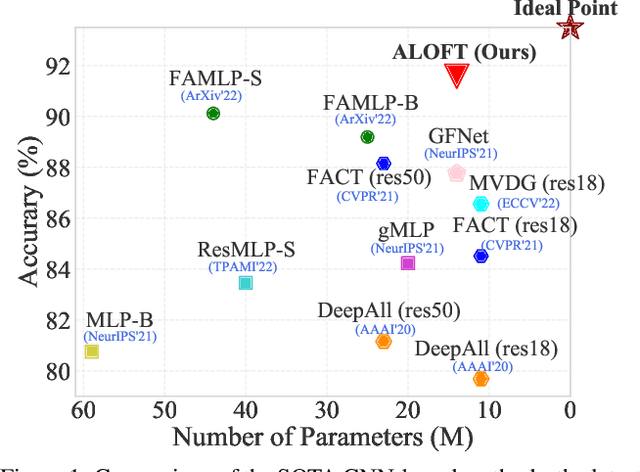
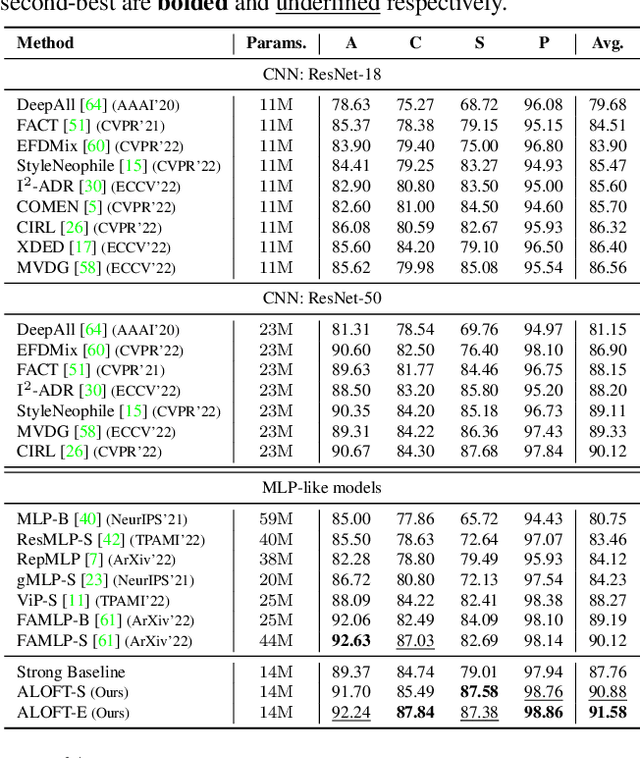
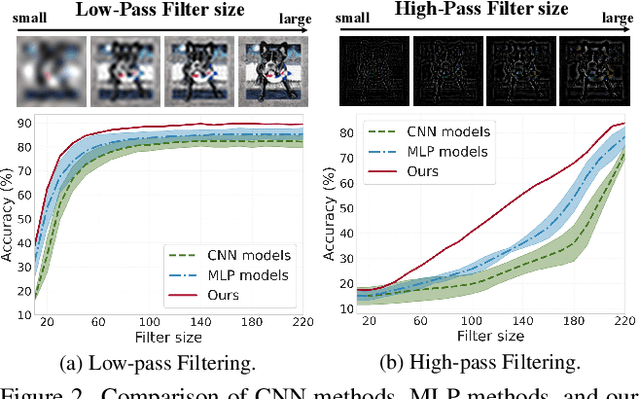
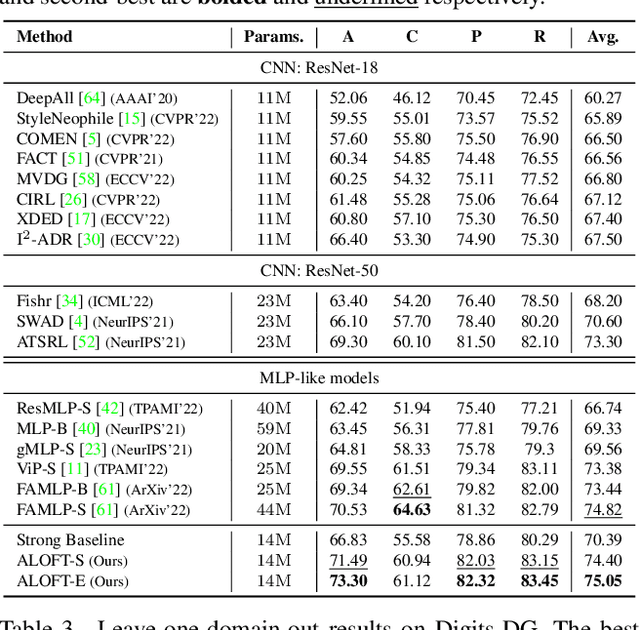
Abstract:Domain generalization (DG) aims to learn a model that generalizes well to unseen target domains utilizing multiple source domains without re-training. Most existing DG works are based on convolutional neural networks (CNNs). However, the local operation of the convolution kernel makes the model focus too much on local representations (e.g., texture), which inherently causes the model more prone to overfit to the source domains and hampers its generalization ability. Recently, several MLP-based methods have achieved promising results in supervised learning tasks by learning global interactions among different patches of the image. Inspired by this, in this paper, we first analyze the difference between CNN and MLP methods in DG and find that MLP methods exhibit a better generalization ability because they can better capture the global representations (e.g., structure) than CNN methods. Then, based on a recent lightweight MLP method, we obtain a strong baseline that outperforms most state-of-the-art CNN-based methods. The baseline can learn global structure representations with a filter to suppress structure irrelevant information in the frequency space. Moreover, we propose a dynAmic LOw-Frequency spectrum Transform (ALOFT) that can perturb local texture features while preserving global structure features, thus enabling the filter to remove structure-irrelevant information sufficiently. Extensive experiments on four benchmarks have demonstrated that our method can achieve great performance improvement with a small number of parameters compared to SOTA CNN-based DG methods. Our code is available at https://github.com/lingeringlight/ALOFT/.
PP-MSVSR: Multi-Stage Video Super-Resolution
Dec 06, 2021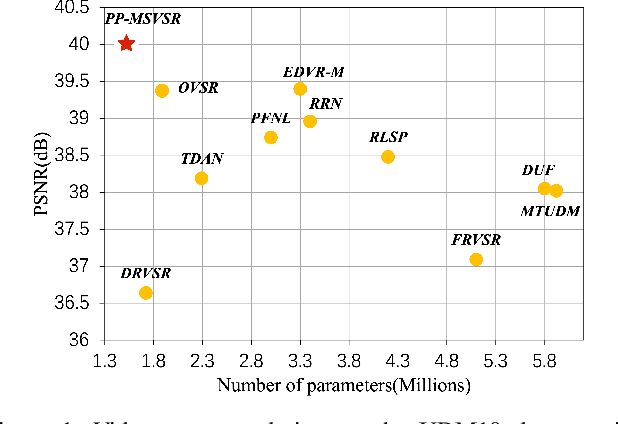
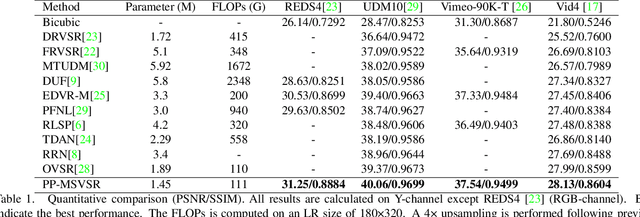
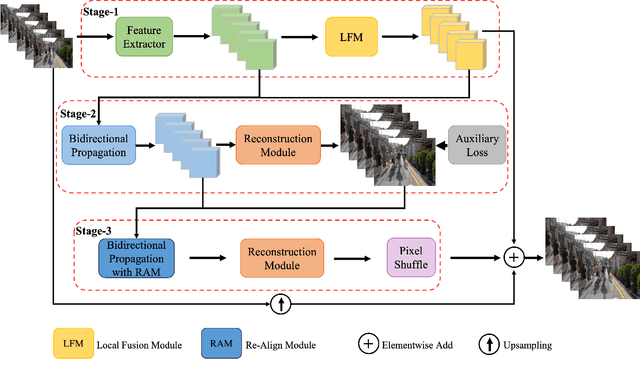

Abstract:Different from the Single Image Super-Resolution(SISR) task, the key for Video Super-Resolution(VSR) task is to make full use of complementary information across frames to reconstruct the high-resolution sequence. Since images from different frames with diverse motion and scene, accurately aligning multiple frames and effectively fusing different frames has always been the key research work of VSR tasks. To utilize rich complementary information of neighboring frames, in this paper, we propose a multi-stage VSR deep architecture, dubbed as PP-MSVSR, with local fusion module, auxiliary loss and re-align module to refine the enhanced result progressively. Specifically, in order to strengthen the fusion of features across frames in feature propagation, a local fusion module is designed in stage-1 to perform local feature fusion before feature propagation. Moreover, we introduce an auxiliary loss in stage-2 to make the features obtained by the propagation module reserve more correlated information connected to the HR space, and introduce a re-align module in stage-3 to make full use of the feature information of the previous stage. Extensive experiments substantiate that PP-MSVSR achieves a promising performance of Vid4 datasets, which achieves a PSNR of 28.13dB with only 1.45M parameters. And the PP-MSVSR-L exceeds all state of the art method on REDS4 datasets with considerable parameters. Code and models will be released in PaddleGAN\footnote{https://github.com/PaddlePaddle/PaddleGAN.}.
One-shot Weakly-Supervised Segmentation in Medical Images
Nov 21, 2021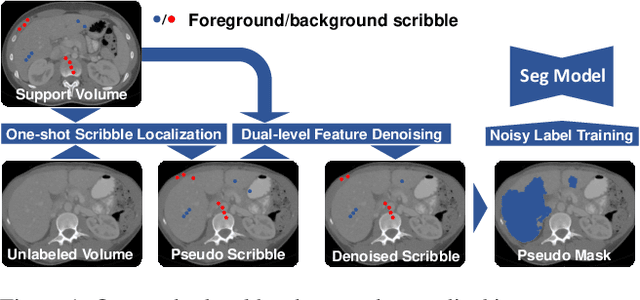

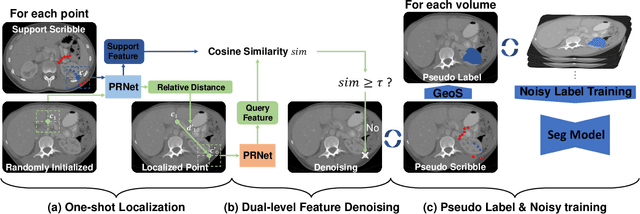

Abstract:Deep neural networks usually require accurate and a large number of annotations to achieve outstanding performance in medical image segmentation. One-shot segmentation and weakly-supervised learning are promising research directions that lower labeling effort by learning a new class from only one annotated image and utilizing coarse labels instead, respectively. Previous works usually fail to leverage the anatomical structure and suffer from class imbalance and low contrast problems. Hence, we present an innovative framework for 3D medical image segmentation with one-shot and weakly-supervised settings. Firstly a propagation-reconstruction network is proposed to project scribbles from annotated volume to unlabeled 3D images based on the assumption that anatomical patterns in different human bodies are similar. Then a dual-level feature denoising module is designed to refine the scribbles based on anatomical- and pixel-level features. After expanding the scribbles to pseudo masks, we could train a segmentation model for the new class with the noisy label training strategy. Experiments on one abdomen and one head-and-neck CT dataset show the proposed method obtains significant improvement over the state-of-the-art methods and performs robustly even under severe class imbalance and low contrast.
Micro- and Macro-Level Churn Analysis of Large-Scale Mobile Games
Jan 14, 2019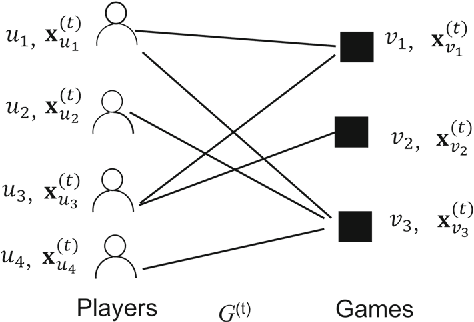
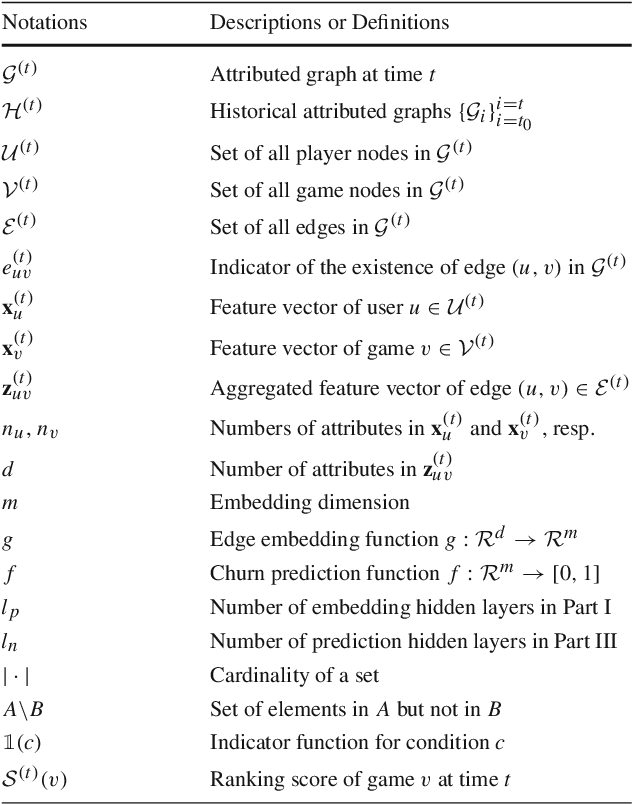
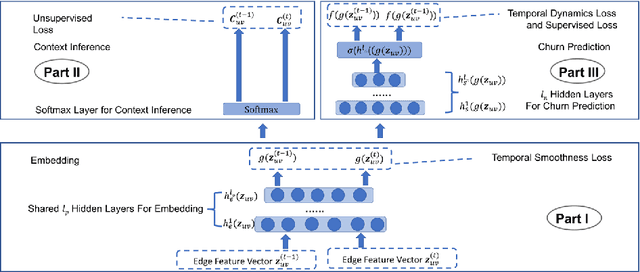

Abstract:As mobile devices become more and more popular, mobile gaming has emerged as a promising market with billion-dollar revenues. A variety of mobile game platforms and services have been developed around the world. A critical challenge for these platforms and services is to understand the churn behavior in mobile games, which usually involves churn at micro level (between an app and a specific user) and macro level (between an app and all its users). Accurate micro-level churn prediction and macro-level churn ranking will benefit many stakeholders such as game developers, advertisers, and platform operators. In this paper, we present the first large-scale churn analysis for mobile games that supports both micro-level churn prediction and macro-level churn ranking. For micro-level churn prediction, in view of the common limitations of the state-of-the-art methods built upon traditional machine learning models, we devise a novel semi-supervised and inductive embedding model that jointly learns the prediction function and the embedding function for user-app relationships. We model these two functions by deep neural networks with a unique edge embedding technique that is able to capture both contextual information and relationship dynamics. We also design a novel attributed random walk technique that takes into consideration both topological adjacency and attribute similarities. To address macro-level churn ranking, we propose to construct a relationship graph with estimated micro-level churn probabilities as edge weights and adapt link analysis algorithms on the graph. We devise a simple algorithm SimSum and adapt two more advanced algorithms PageRank and HITS. The performance of our solutions for the two-level churn analysis problems is evaluated on real-world data collected from the Samsung Game Launcher platform.
 Add to Chrome
Add to Chrome Add to Firefox
Add to Firefox Add to Edge
Add to Edge